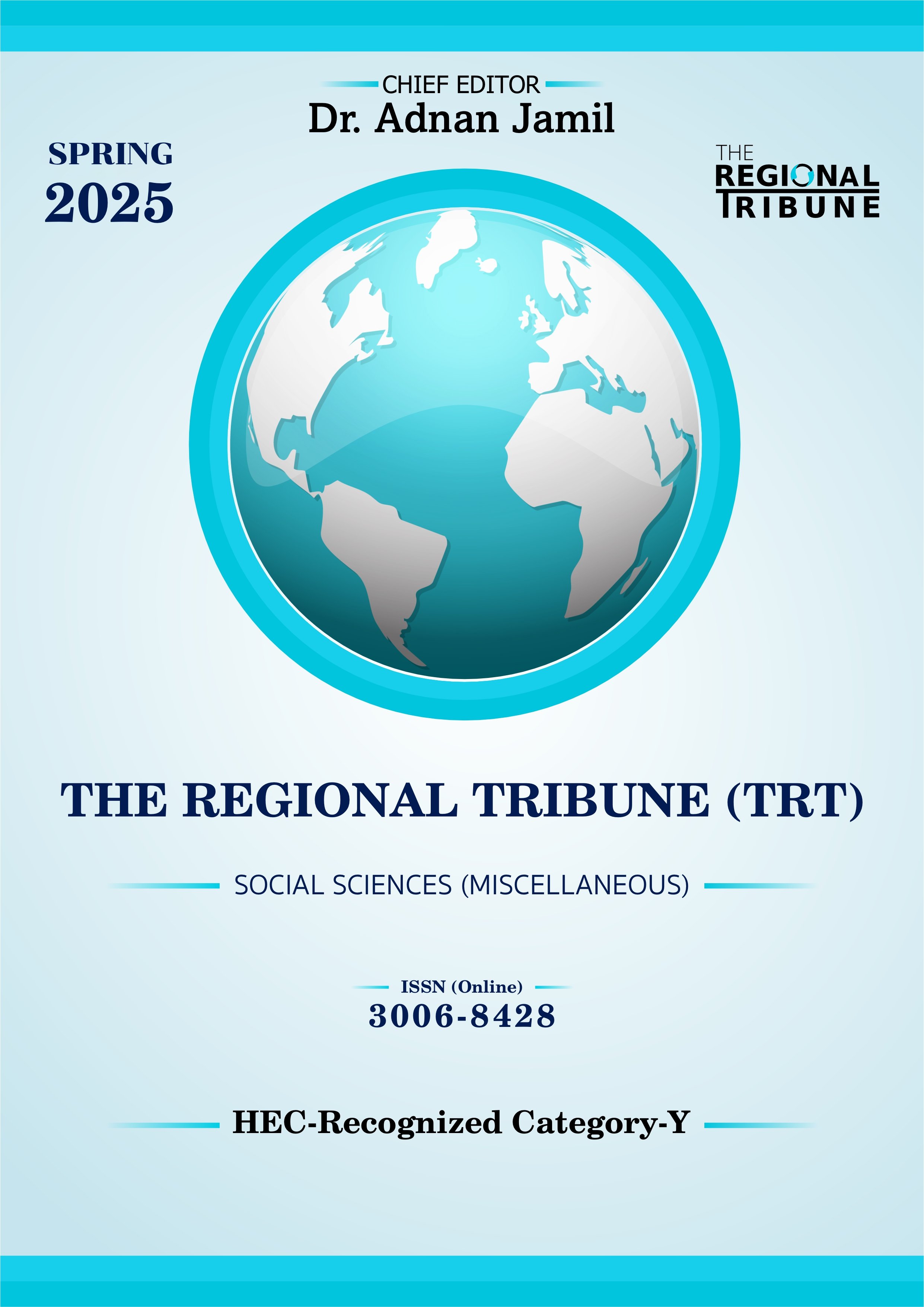Digital Resilience as a Catalyst for Adaptive Performance and Stress Reduction: The Moderating Role of Learning Agility in Pakistan’s Treasury Offices
DOI:
https://doi.org/10.55737/trt/SG25.101Keywords:
Digital Resilience, Learning Agility, Adaptive Performance, Technostress, Treasury Offices, PakistanAbstract
This study explores how digital resilience (DR) influences adaptive performance (AP) and stress reduction (SR) among employees in the Treasury Offices of Sukkur and Khairpur, and whether learning agility (LA) mediates these relationships. A proportionate stratified random sample of 210 treasury clerks and supervisors completed validated scales for DR, LA, AP and technology-related stress (reverse-scored as SR). Data were analysed with SmartPLS 4, employing a two-stage approach: (1) assessment of reliability and validity; (2) 5,000-sample bootstrapped structural modelling. DR exerted significant positive effects on AP (β = 0.43, p < .001) and SR (β = 0.35, p < .001). DR also predicted LA (β = 0.58, p < .001), which, in turn, enhanced AP (β = 0.31) and SR (β = 0.27). Indirect effects confirmed partial mediation (DR → LA → AP: β = 0.18; DR → LA → SR: β = 0.16). The model explained 47 % of the variance in AP and 38 % in SR, demonstrating the combined importance of resilience and learning agility for digital public-finance work. Treasury managers should pair technical upskilling with resilience-building drills and learning-agility initiatives, such as stretch assignments and reflective debriefs, to maximise employee adaptability and minimise technostress during digital transformation. This paper extends resilience research to a South-Asian public-finance context and empirically identifies learning agility as a mechanism through which digital resilience translates into superior adaptive outcomes and lower stress.
References
Adamson, D., Dyke, G., Jang, H., & Rosé, C. P. (2014). Towards an agile approach to adapting dynamic collaboration support to student needs. International Journal of Artificial Intelligence in Education, 24(1), 92–124. https://doi.org/10.1007/s40593-013-0012-6
Afshar, M. Z., & Shah, M. H. (2025). Resilience Through Adaptation: Examining the Interplay Between Adaptive Capacity and Organizational Resilience in Public Sector Organizations. ACADEMIA International Journal for Social Sciences, 4(2), 1770–1789. http://dx.doi.org/10.63056/ACAD.004.02.0289
Ahmadi-Assalemi, G., Al-Khateeb, H., Epiphaniou, G., & Maple, C. (2020). Cyber resilience and incident response in smart cities: A systematic literature review. Smart Cities, 3(3), 894–927. https://doi.org/10.3390/smartcities3030046
Alobayli, F. (2024). Impact of EHRs on nursing burnout in a hospital setting in Saudi Arabia: Mixed-methods study. Studies in Health Technology and Informatics, 315, 322–326. https://doi.org/10.3233/SHTI240161
Ayyagari, R., Grover, V., & Purvis, R. (2011). Technostress: Technological antecedents and implications. MIS quarterly, 831-858. https://doi.org/10.2307/41409963
Ballangan, M. G., Carantes, F. T., & Yanes Jr, P. S. (2024). Unpacking technostress: a systematic review on its effects and mitigation. CJMS, 4, 11-21.
Carmeli, A., & Hartmann, S. (2024). Learning agility orientation, ambidextrous learning, and resilience. IEEE Transactions on Engineering Management, 71, 12946-12959. http://dx.doi.org/10.1109/TEM.2024.3357531
Carter, J.G., Grommon, E., Frantz, F. (2014). Impact of Mobile Broadband Data Access on Police Operations: An Exploratory Case Study of One Medium-Sized Municipal Police Department. Engility Corporation, Rome NY. [U.S. DOJ Award Number: 2010-IJ-CX-K023] https://www.ojp.gov/pdffiles1/nij/grants/250261.pdf
Cascio, W. F., & Montealegre, R. (2016). How technology is changing work and organizations. Annual Review of Organizational Psychology and Organizational Behavior, 3, 349–375. https://doi.org/10.1146/annurev-orgpsych-041015-062352
Coutu, D. L. (2002). How resilience works. Harvard business review, 80(5), 46-56.
DeRue, D. S., Ashford, S. J., & Myers, C. G. (2012). Learning agility: In search of conceptual clarity and theoretical grounding. Industrial and Organizational Psychology, 5(3), 258–279. https://doi.org/10.1111/j.1754-9434.2012.01444.x
Evans, A. (2022). Enterprise Cybersecurity in Digital Business: Building a Cyber Resilient Organization. Routledge.
Goraya, M. A. S., Yaqub, M. Z., Khan, M. A., Akram, M. S., & Alofaysan, H. (2024). Transforming performance: how agility, response, resilience and support shape success in digital strategies. Information Technology & People. https://doi.org/10.1108/itp-05-2024-0592
Hadiono, A. (2023). High potential employee learning agility: individual differences, learning climate and the role of Human Resource Management (HRM) function (Doctoral dissertation, University of Glasgow).
Hair Jr, J. F., Hult, G. T. M., Ringle, C. M., Sarstedt, M., Danks, N. P., & Ray, S. (2021). Partial least squares structural equation modeling (PLS-SEM) using R: A workbook (p. 197). Springer Nature.
Haring, S., Shankar, J., & Hofkes, K. (2020). The potential of learning agility. https://www.hfmtalentindex.com/documents/91/The-Potential-of-Learning-Agility-Research-Paper-1.pdf
International Monetary Fund. (2021). Digitalization in public financial management: Opportunities and challenges. IMF Fiscal Affairs Department.
Jayawickrama, B., & Karunathilaka, G. (2022). Presilience for Enhancing Organizational Adaptive Performance within the Sri Lankan Private Sector. International Journal of Contemporary Business Research, 140.
John, D. R. (2012). The Offshoring Industry in India: Moving Up the Value Chain?. In Innovation in India: The Future of Offshoring (pp. 49-73). London: Palgrave Macmillan UK.
Krejcie, R. V., & Morgan, D. W. (1970). Determining sample size for research activities. Educational and Psychological Measurement, 30(3), 607–610. https://doi.org/10.1177/001316447003000308
Kuntz, J. C. (2021). Resilience in times of global pandemic: Steering recovery and thriving trajectories. Psychologie Appliquee [Applied Psychology], 70(1), 188–215. https://doi.org/10.1111/apps.12296
Mitchinson, A., & Morris, R. (2014). Learning about learning agility. Center for Creative Leadership, 10.
Naeem, N. I. K., & Mushibwe, C. P. (2025). Navigating digital worlds: a scoping review of skills and strategies for enhancing digital resilience among higher education students on social media platforms. Discover Education, 4(1), 1-15. https://doi.org/10.1007/s44217-025-00432-7
Pulakos, E. D., Arad, S., Donovan, M. A., & Plamondon, K. E. (2000). Adaptability in the workplace: Development of a taxonomy of adaptive performance. Journal of Applied Psychology, 85(4), 612–624. https://doi.org/10.1037/0021-9010.85.4.612
Repetto, M. (2023). Adaptive monitoring, detection, and response for agile digital service chains. Computers & Security, 132(103343), 103343. https://doi.org/10.1016/j.cose.2023.103343
Robertson, I. T., Cooper, C. L., Sarkar, M., & Curran, T. (2015). Resilience training in the workplace from 2003 to 2014: A systematic review. Journal of Occupational and Organizational Psychology, 88(3), 533–562. https://doi.org/10.1111/joop.12120
Syed, R., Bandara, W., & Eden, R. (2023). Public sector digital transformation barriers: A developing country experience. Information Polity, 28(1), 5–27. https://doi.org/10.3233/ip-220017
Tarafdar, M., & Stich, J. F. (2021). Virtual work, technology and wellbeing. In The SAGE Handbook of Organizational Wellbeing (pp. 159-169). London: Sage.
Van der Vegt, G. S., Essens, P., Wahlström, M., & George, G. (2015). Managing risk and resilience. Academy of Management Journal, 58(4), 971–980. https://doi.org/10.5465/amj.2015.4004
Yener, S., Arslan, A., & Kilinç, S. (2021). The moderating roles of technological self-efficacy and time management in the technostress and employee performance relationship through burnout. Information Technology & People, 34(7), 1890–1919. https://doi.org/10.1108/itp-09-2019-0462
Downloads
Published
Issue
Section
License

This work is licensed under a Creative Commons Attribution-NonCommercial 4.0 International License.



